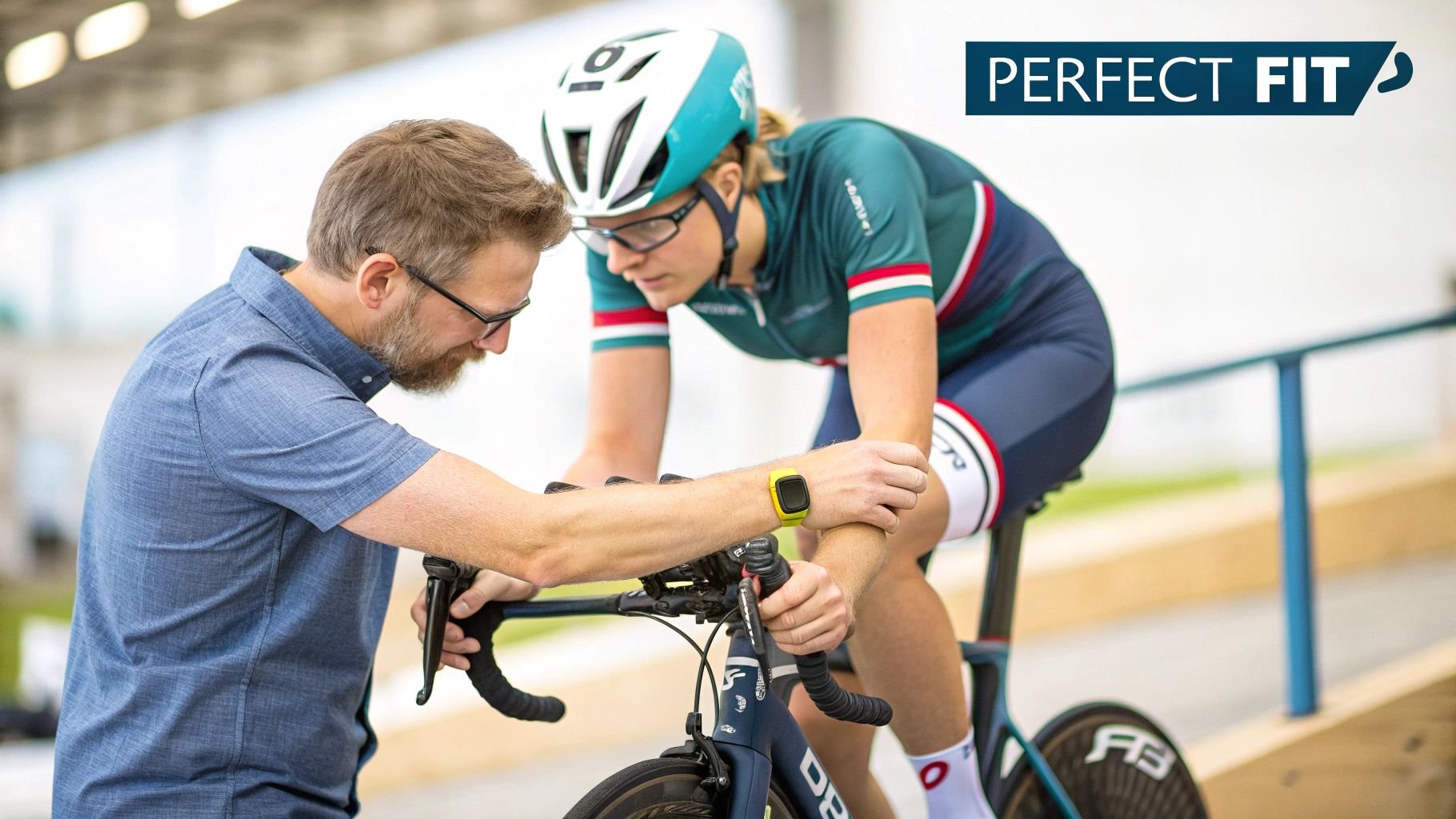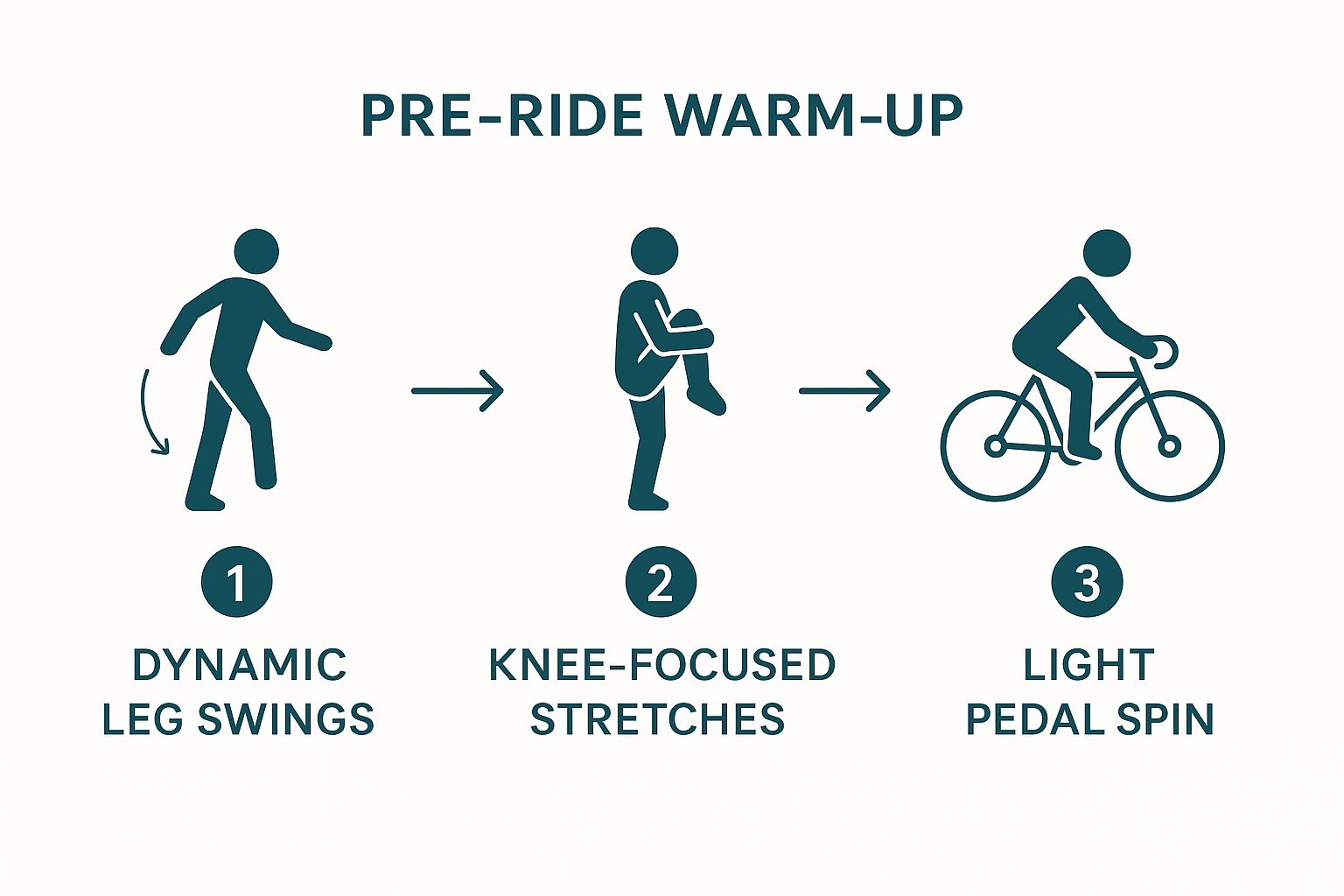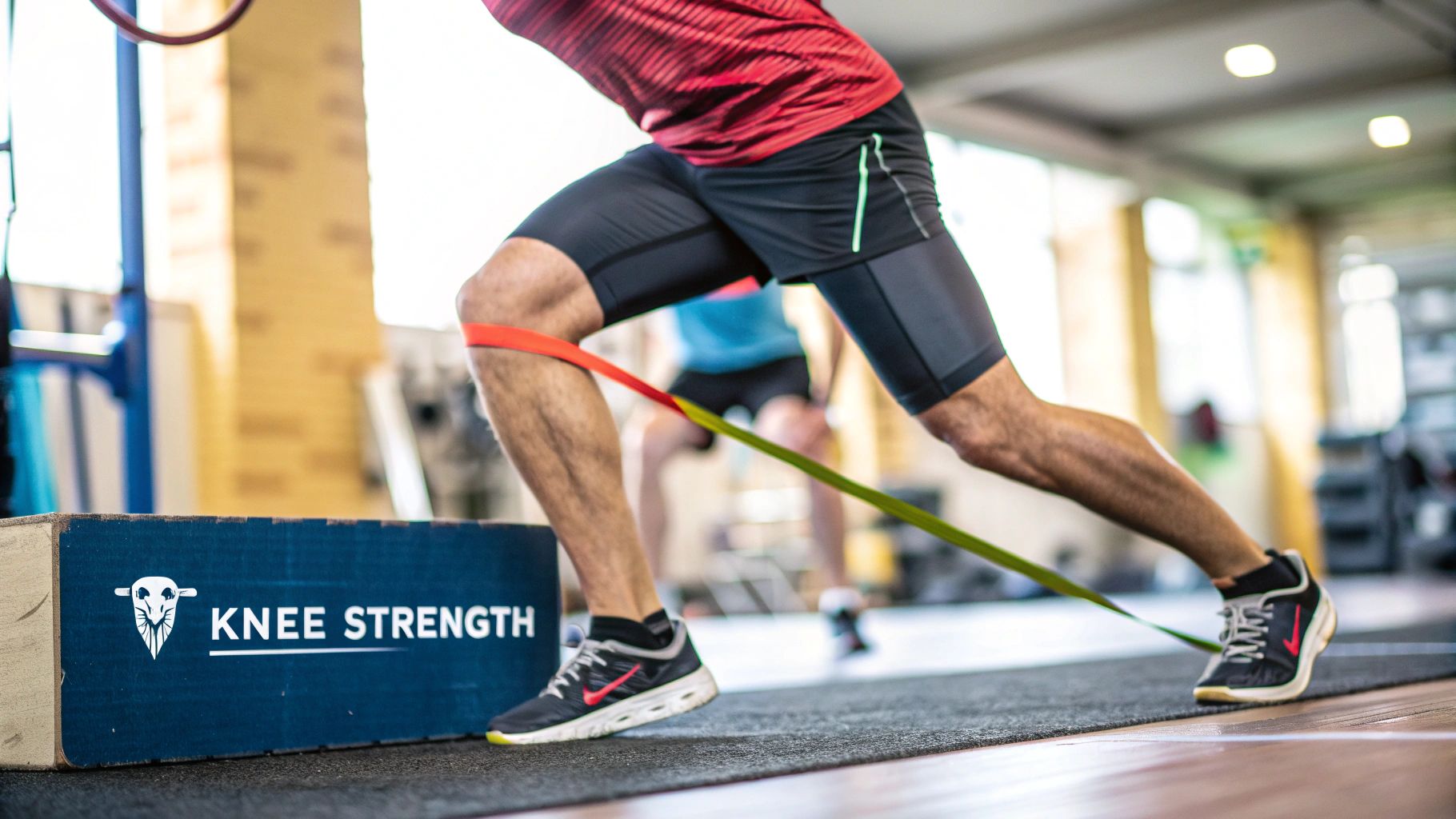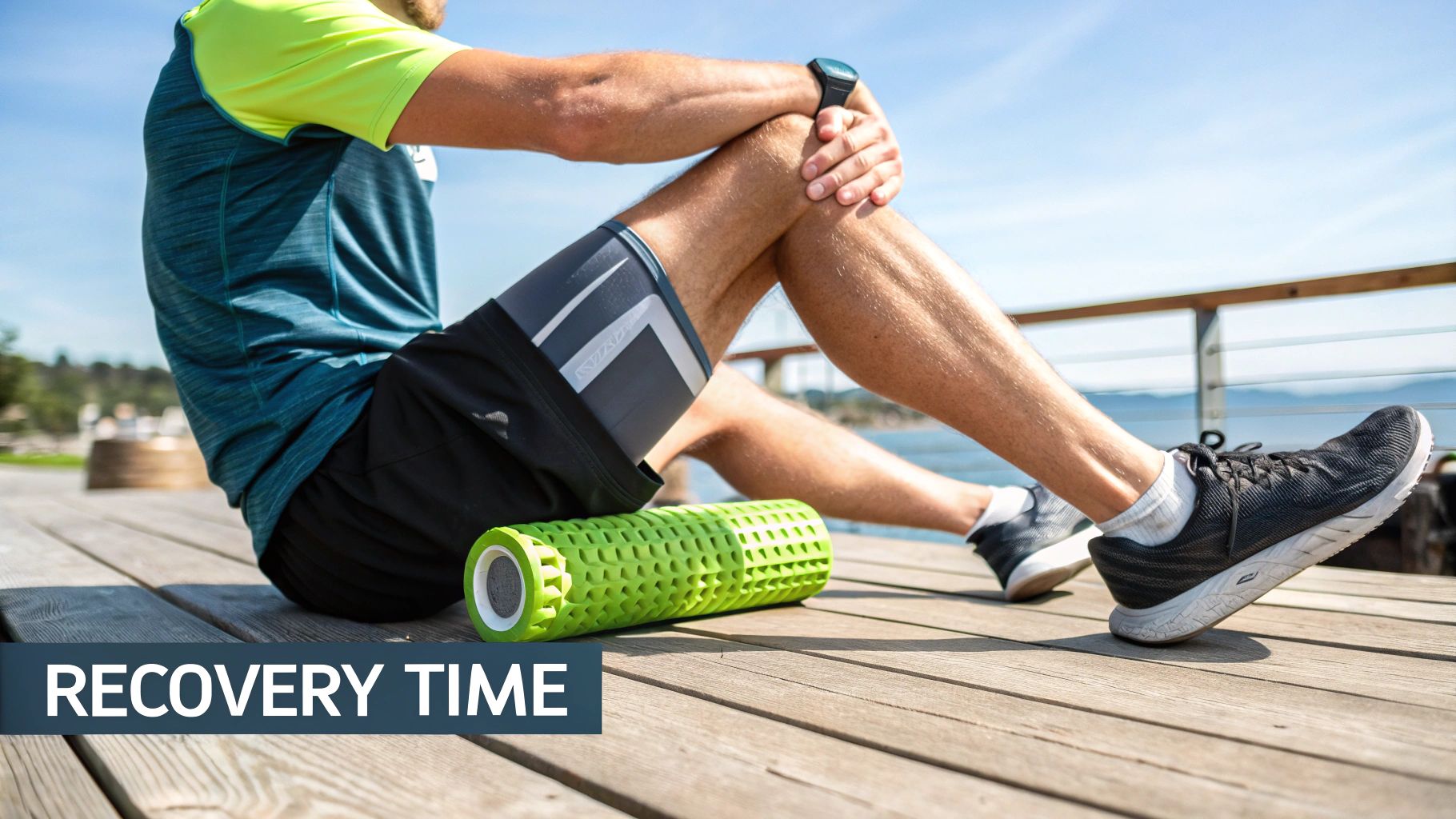.webp)
If you’ve ever hopped off your bike feeling a dull ache or a sharp twinge in your knees, you're not alone. It's one of the most common complaints I hear from cyclists, whether they're weekend riders or seasoned racers. It's incredibly frustrating when the hobby you love starts to feel like a chore.
Here’s the thing: the problem usually isn't cycling itself. Cycling is famously low-impact. The real issue is the repetitive nature of the pedal stroke—we’re talking over 5,000 revolutions on an hour-long ride—magnifying any small imperfection in your bike fit or your body's mechanics.
Think of that pain as a signal. Your body is telling you something is out of sync. The good news? It's almost always fixable.
The first step to solving the problem is to play detective. Where exactly does it hurt? The location of the pain is the biggest clue to what’s gone wrong.
To get you started, here’s a quick rundown of the most common pain points and what they typically mean for cyclists.
Use this table to quickly match where your knee hurts with the most common cycling-related cause, helping you pinpoint the problem.
This isn't just anecdotal, either. Knee pain is statistically the most frequent overuse injury for UK cyclists, with studies showing that somewhere between 40% and 60% of riders will experience it. A detailed analysis of road cyclists on PMC confirmed the knee as the number one trouble spot.
The key takeaway is that knee pain is a symptom, not the disease. Your body is sending you a message that something in the complex chain of movement—from your hips to your ankles—is out of alignment.
This guide will help you troubleshoot your setup, training habits, and conditioning. Many issues can be sorted with a few simple adjustments. But if the pain just won't go away, it might be time for an expert eye.
For those more stubborn cases, our specialists in sports and exercise medicine at The Vesey can provide a detailed diagnosis to get you back on the road, pain-free.

To solve your knee pain, you first need to learn its language. Where you feel that ache isn't random—it's a direct clue pointing to the likely cause. Think of your knee as a compass, with each direction telling a different story about your bike fit or riding technique.
Let's break down the common pain patterns and what they typically signal. This isn't about self-diagnosing, but about connecting the dots between what you're feeling and a specific mechanical issue on the bike.
Anterior knee pain—that dull, aching sensation on or around your kneecap—is by far the most common complaint we see from cyclists. It tends to flare up when you’re pushing a big gear or grinding up a steep climb.
More often than not, this is a tell-tale sign that your saddle is too low.
When your saddle is too low, your knee is forced into an aggressive bend at the top of the pedal stroke. This puts a huge amount of strain on your quadriceps and the patellar tendon, which connects your kneecap to your shinbone. Over thousands of revolutions, that repeated stress leads to inflammation and pain. A saddle that’s too far forward can cause a similar problem.
If the pain feels like a constant, nagging irritation of that tendon, you might want to learn more about the symptoms of tendonitis to better understand the condition.
Posterior knee pain, felt in the crease behind your knee, is less common but just as frustrating. This type of discomfort is almost always linked to one thing: overextension.
The usual culprit is a saddle that's too high or positioned too far back. When you have to constantly reach for the pedal at the bottom of the stroke, you end up overstretching the hamstring tendons right where they attach behind the knee. It’s a fast track to strain and inflammation, particularly in the biceps femoris tendon.
Here’s a simple check: if you feel your hips rocking from side to side just to keep your feet on the pedals, your saddle is almost certainly too high.
Your knee is designed to operate within an optimal range of motion. Pushing it beyond this range by overextending or excessively flexing the joint is a direct path to developing sore knees after cycling.
Pain on the inner (medial) or outer (lateral) side of the knee nearly always points to an issue with your foot and lower leg alignment. And the source of that problem can usually be traced back to your cleats.
An incorrect cleat setup is an incredibly common cause of sore knees because it forces the joint to move in an unnatural, inefficient way. Getting the rotation and side-to-side position of your cleats dialled in is absolutely fundamental for pain-free riding.
When it comes to preventing knee pain, your bike fit is everything. Honestly, it's the single most important factor. Think of it as the foundation for every comfortable, powerful ride you go on. A poor fit forces your knees into awkward, unnatural angles, and after thousands of pedal strokes, even a tiny misalignment can flare up into serious discomfort.
Your bike should fit you like a tailored suit. A few millimetres here or there makes all the difference between feeling strong and feeling pinched. The good news is you can make some really effective adjustments yourself, just by focusing on the three main contact points between you and your bike.
Let's start with the most common culprit behind sore knees: saddle height. It's a classic mistake. If your saddle is too low, you'll probably feel a nagging pain in the front of your knee. Too high, and the strain tends to show up at the back.
A great way to get into the right ballpark is the 'heel-on-pedal' method. Prop yourself up against a wall or on a trainer, sit on the saddle, and place your heel on the pedal. At the very bottom of the pedal stroke, your leg should be almost completely straight. This simple trick is your starting point. From there, it's all about making tiny adjustments until it feels just right.

This image shows a simple warm-up routine that’s brilliant for prepping your knees, especially after you've tinkered with your bike fit. Getting some dynamic movement in before a ride improves blood flow and joint mobility, making your knees far more resilient to the demands of cycling.
Next up is the fore/aft position—that’s how far forward or back your saddle is clamped onto its rails. This adjustment has a huge impact on where your knee sits over the pedal, which directly affects the forces going through your kneecap.
Here’s how to check it. Clip in and bring your pedals to a horizontal position (think 3 o'clock and 9 o'clock). Now, look at your front knee. It should be positioned directly above the axle of the pedal. If your knee is too far forward, you’re stressing the front of the joint. Too far back, and you risk straining your hamstrings.
One Small Change at a Time: This is the golden rule of bike fitting. Only ever make one small adjustment per ride. Nudge your saddle forward 2mm, go for a short spin, and see how it feels. This methodical approach stops you from overcorrecting and accidentally creating a whole new problem.
Finally, let's talk cleats. This is often the most technical part of the setup, but it’s arguably one of the most vital for preventing pain on the inside or outside of your knee. Your cleat position dictates your 'Q-factor' (how wide your feet are apart) and the rotational angle of your foot on the pedal.
If the angle is wrong, it can force your knee to track inwards or outwards with every single pedal stroke, straining the ligaments on either side. Most of us have a natural 'toe-out' angle when we walk, and your cleat setup needs to mirror that.
This isn't just about minor aches, either. Knee pain is a massive issue for cyclists. A UK study found the lifetime prevalence of knee pain among cyclists was a staggering 48%. That number climbs even higher for those over 40, which really hammers home how crucial a proper setup becomes as we get older.
While these DIY tips can get you a long way, nailing the perfect fit is a complex business. For a deeper understanding of your body's unique alignment, tools like posture analysis software can offer incredible insights. Of course, for a truly bespoke fit, nothing beats a professional ergonomic assessment at The Vesey, where our experts can analyse your biomechanics in detail.
https://www.youtube.com/embed/ikt6NME0k9E
What you do off the bike is every bit as important as your setup on it. The powerful, repetitive motion of cycling is fantastic for building your quads, but this can easily lead to significant muscle imbalances. Over time, those dominant quads and tight supporting muscles start pulling on the kneecap, disrupting its natural tracking and causing that all-too-familiar ache.
To head this off, you need a two-pronged attack that focuses on both flexibility and strength. This isn't just about easing the pain you feel now; it's about building a more resilient, balanced body to stop sore knees from coming back. A bit of proactive work here is a total game-changer for long-term comfort in the saddle.
Getting into a routine of static stretching after your ride is crucial for releasing the tension that builds up in key muscle groups. Hold each stretch for a good 30-45 seconds—this gives the muscle fibres enough time to actually lengthen and helps restore balance around the knee joint.
You'll want to focus on four main areas:
This diagram clearly shows the path of the IT band, running all the way from the hip down past the knee.

You can see how tightness in this band creates friction and inflammation right where it passes over the outer part of the knee. This is what leads to that sharp, localised pain many cyclists feel. A figure-four stretch is brilliant for releasing both the glutes and these connected tissues.
While stretching tackles tightness, strength work is what corrects the underlying imbalances for good. Your best defence against poor knee alignment during the pedal stroke? Strong glutes and a solid core. When your glutes are weak, your knees often collapse inward—a movement pattern that puts a huge amount of stress on the joint.
Try to weave these foundational exercises into your routine 2-3 times a week:
Building a stronger support system around your knees with targeted exercises is one of the most effective long-term strategies for preventing pain. It shifts the workload away from the vulnerable joint and onto the powerful muscles designed to handle it.
Understanding the benefits of exercise beyond cycling can be a great motivator for building this crucial off-bike routine into your lifestyle. Honestly, a little strength work goes a very long way.

While most sore knees from cycling can be sorted with a few tweaks at home, it's vital to recognise when a small niggle is actually a warning sign. Pushing through the wrong kind of pain is a surefire way to turn a minor issue into a chronic injury that could keep you off the bike for months.
You have to learn to listen to your body. If the pain is sharp, doesn't fade after a couple of days of rest, and keeps coming back, it’s time to stop guessing and get an expert opinion.
Other clear red flags include:
Don't wait for a minor ache to become a major problem. Early intervention is the fastest route back to pain-free cycling.
Knowing who to call is the first step to getting the right kind of help. Your two main ports of call are a professional bike fitter and a medical expert, but they solve very different problems.
A professional bike fitter is your go-to for mechanical issues. They’re experts in analysing your position, pedalling technique, and the way you interact with the bike. Their goal is to optimise your setup and get rid of pain caused by poor alignment or an ill-fitting machine.
A medical expert, like a physiotherapist or an orthopaedic specialist, is there to diagnose underlying physical problems. They’ll look at what’s going on inside your body—things like muscle imbalances, tendon damage, or joint issues that cycling might be making worse.
Putting off a consultation can seriously drag out your recovery. Research shows that while professional cyclists tend to seek medical help for knee pain within about three months, amateur riders often wait nearly two years. That delay can make treatment far more complicated, as there are many different clinical issues that can be causing the pain.
If self-care and bike fit adjustments haven't worked, a proper medical evaluation is the next logical step. The team at The Vesey can provide a detailed diagnosis, with experts in orthopaedic surgery on hand for more complex cases. When the usual measures aren't cutting it, you might also consider exploring a masterclass on healing injuries to get a deeper understanding of the recovery process.
Even after making a few adjustments, it's completely normal to have lingering questions about sore knees. Getting back to pain-free riding is often a process of trial and error, so let's clear up a few common queries we hear from cyclists.
Not always, but you absolutely have to listen to your body. If the pain is sharp, severe, or sudden, then yes—taking a complete break for a few days is the smart move.
However, for those familiar dull aches, you could try dialing back the intensity and distance first. Think short, flat rides with a high cadence (fast, light pedalling). This puts far less strain on the knee joint than grinding up hills in a big gear and can help you figure out what triggers the pain without having to stop completely.
Yes, they can make a massive difference. Look for pedals with more "float"—that’s the term for the small amount of rotational movement your foot has while clipped in. This little bit of wiggle room is a game-changer, allowing your knee, ankle, and hip to settle into their most natural alignment with every pedal stroke.
If your cleats are fixed with zero float, your foot is locked into one rigid position. If that alignment isn't perfect for your unique biomechanics, it can force your knee to track unnaturally, often leading to strain on the inside or outside of the joint.
This varies hugely from person to person and depends entirely on the root cause. If your sore knees are down to a simple bike fit issue, you could feel relief almost instantly after making an adjustment.
For overuse injuries like tendonitis, recovery is more of a slow burn. You’re likely looking at a few weeks of reduced mileage combined with consistent stretching and strength work. The key here is patience and consistency. Pushing too hard, too soon, will only set you back. If the pain sticks around for more than two weeks despite your best efforts, that’s a clear signal to get some professional advice.
If you're struggling to pinpoint the cause of your knee pain or if it's just not getting better, the expert team at The Vesey can provide a thorough diagnosis and a personalised treatment plan to get you back in the saddle, pain-free. Find out how we can help at thevesey.co.uk.

